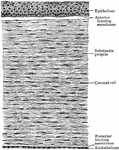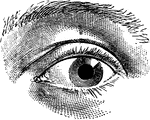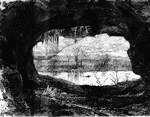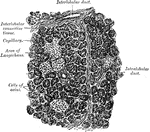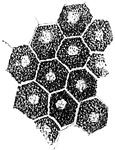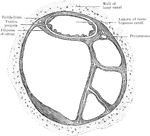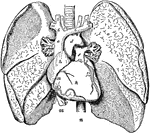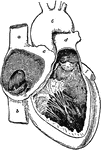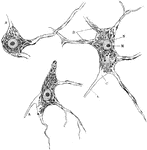
Neuron of Spinal Cord
Nerve cells of human spinal cord stained to show Nissl bodies. Labels: D, dendrites; A, axons; C, implantation…
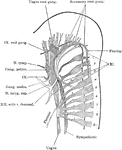
Peripheral Nerves of Human Embryo
Reconstruction of peripheral nerves of human embryo of five weeks.

Hand Pointing
The hand is the intricate, multi-fingered body part normally located at the end of each arm of a human.

Transverse Section of Ureter
In human anatomy, the ureters are muscular tubes that propel urine from the kidneys to the urinary bladder.
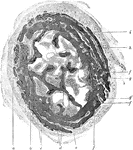
Developing Bone
Cross section of developing bone of human fetus of four months. Labels: a, periostem; b, boundary between…
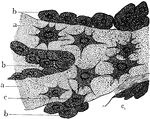
Osteoblasts from Embryo
Osteoblasts from the parietal bone of a human embryo thirteen weeks old. Labels: a, bony septa with…

Human Flea
The human flea (Pulex irritans) is a parasitic insect that actually has several hosts despite its name.
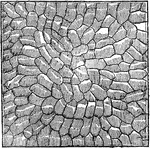
Microscopic view of a leaf
"The branch vascular bundles will be distinctly seen, resembling in some respects the arteries and veins…
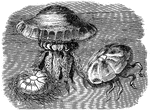
Rhyzostoma Cuvierii
"These fragile creatures are able to make long voyages on the surface of the sea. Their nature is such…
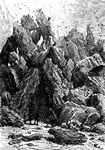
Cave
An illustration of a cliff with with a cave. A cave is a natural underground void large enough for a…
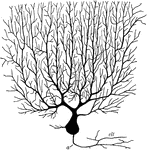
Purkinjean Cell from Cerebellum
Purkinjean cell from human cerebellum, as seen in a plane transverse to the long axis of a cerebellar…

Longitudinal Section Through Fingernail
Longitudinal section through human nail and its nail groove (sulcus).
Transverse Section Through Fingernail
Transverse section through human nail and its nail groove (sulcus).
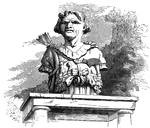
Bust of Man
A bust is a sculpted or cast representation of the upper part of the human figure, depicting a person's…
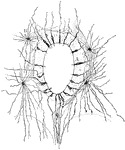
Section Through Spinal Cord Showing Neuroglial Cell
Section through the central canals of the spinal cord of a human embryo, showing ependymal (A) and neuroglial…

Brain and Spinal Cord of Fetus
Human fetus in the third month of development, with the brain and spinal cord exposed from behind.

Development of Human Brain
Two stages in the development of the human brain. A. Brain of an human embryo of the third week. B.…

Section Through Forebrain of Human and Lepidosteus Embryos
Two cross sections through the forebrain. A. Through the forebrain of the early human embryo. B. Through…
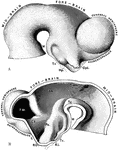
Brain of Embryo
The brain of a human embryo in the fifth week. A, Brain as seen in profile. B, Mesial section through…
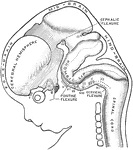
Brain of Embryo
Profile view of brain of a human embryo of ten weeks. The various cranial nerves are indicated by numerals.…
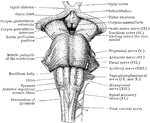
Front view of Medulla, Pons, and Mesencephalon
Front view of the medulla, pons, and mesencephalon of a full term human fetus.
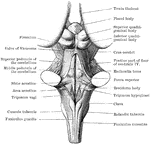
Back View of Medulla, Pons, and Mesencephalon
Back view of the medulla, pons, and mesencephalon of a full term human fetus.
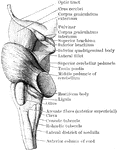
Lateral View of Medulla, Pons, and Mesencephalon
Lateral view of the medulla, pons, and mesencephalon of a full term human fetus.
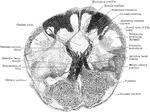
Transverse Section Through Closed Part of Medulla
Transverse section through the closed part of the human medulla immediately above the decussation of…
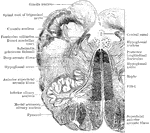
Section Through Medulla in Olivary Region
Transverse section through the human medulla in the lower olivary region.

Section Through Medulla in Olivary Region
Transverse section through the the middle of the olivary region of the human medulla or bulb.
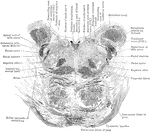
Section Through Pons Varolii
Section through the lower part of the human pons varolii immediately above the medulla.
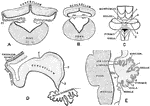
Development of Cerebellum
Showing the development of the cerebellum. A, Transverse section through the forepart of the cerebellum…
Biscayne Bay
An illustration of Biscayne Bay, is a lagoon that is approximately 35 miles (56 km) long and up to 8…
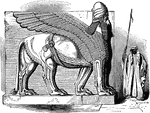
Shedu
The Shedu is a celestial being from Mesopotamian mythology. He is a human above the waist and a bull…
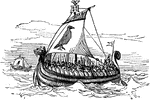
Norse Galley
An illustration of a Norse Galley. Norse is an adjective relating things to Norway, Denmark, Faroe Islands,…
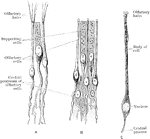
Olfactory and Supporting Cells
Olfactory and supporting cells in a frog and a human. A. Frog. B. Human. C. Human.

Cones and Rods of Retina
A. A cone and two rods from the human retina (modified from Max Schultze); B. Outer part of rod separated…
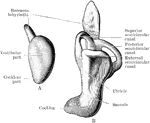
Development of Labyrinth
A, Left labyrinth of a human embryo of about four weeks; B, left labyrinth of a human embryo of about…

Tongue of Human and Rabbit
A, Section through papilla vallata of a human tongue. B, Section through part of the papilla foliata…
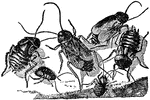
Cockroach
An illustration of a male (right) and female (left) cockroach. Cockroaches (or simply "roaches") are…

Watercress
Watercresses are fast-growing, aquatic or semi-aquatic, perennial plants native from Europe to central…
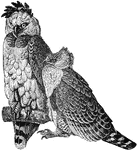
American Harpy Eagle
The American Harpy Eagle (Harpia harpyja) is a neotropical eagle, often simply called the Harpy Eagle.…
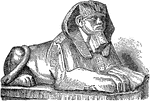
Sphinx
A Sphinx is a zoomorphic mythological figure which is depicted as a recumbent lion with a human head.

Chirotherium Tracks
An illustration of a fossil containing Chirotherium tracks. Chirotherium (also known as Cheirotherium)…
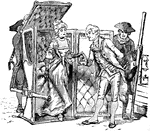
Sedan
The sedan or litter is a wheelless, human-powered vehicle used to carry one person sitting inside.
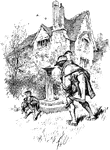
Pixy and a Man
A pixy named Thomas alarmed that a human has just invaded his lawn by jumping over Thomas' wall.

Foxglove
An illustration of: 1, Coralla cut open showing the four stamens; 2, Unripe fruit (lengthwise); 3, ripe…

Masked Crab
Corystes cassivelaunus, the masked crab, helmet crab or sand crab, is a burrowing crab of the North…
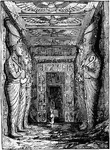
Entrance to the Great Temple at Abu Simbel
In 1959 an international donations campaign to save the monuments of Nubia began: the southernmost relics…
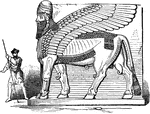
Winged Bull from Nimrud
The Sumerian word lama, which is rendered in Akkadian as lamassu, refers to a beneficient protective…
Caryatis from the Erechtheum at Athens
Caryatides are a blending of architecture and sculpture, but they are not of frequent occurrence. These…
Profile of the Caryatis with Pedestal and Entablature
Caryatides are a blending of architecture and sculpture, but they are not of frequent occurrence. These…

Bacchus Mask
The Bacchus Mask (Greek God of wine) is a Graeco Italic style. It is a fragment of a vessel or utensil.
